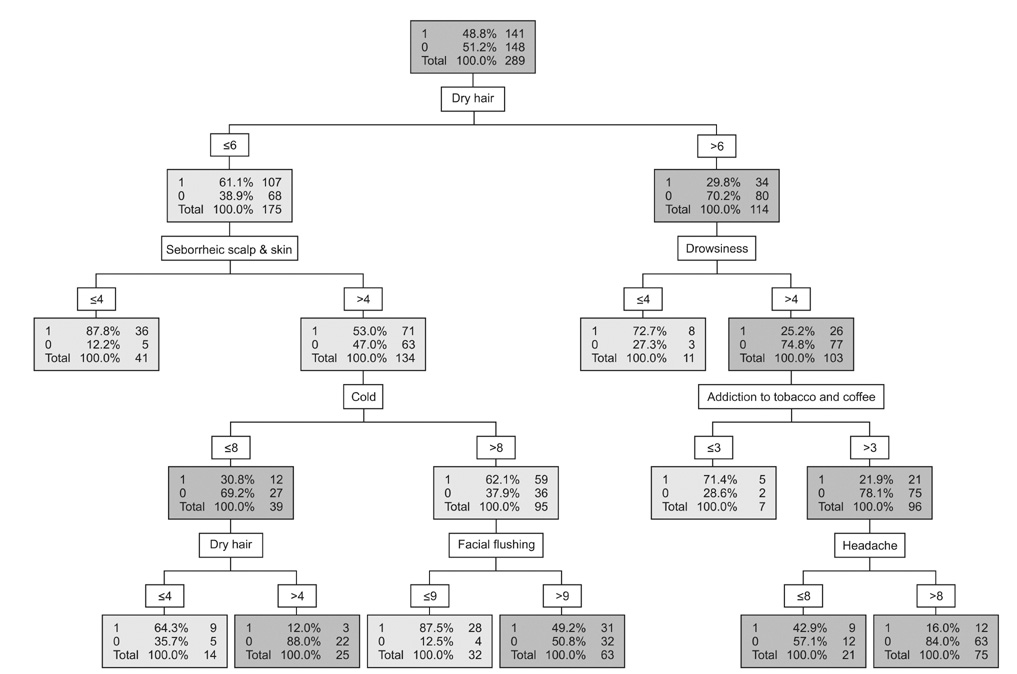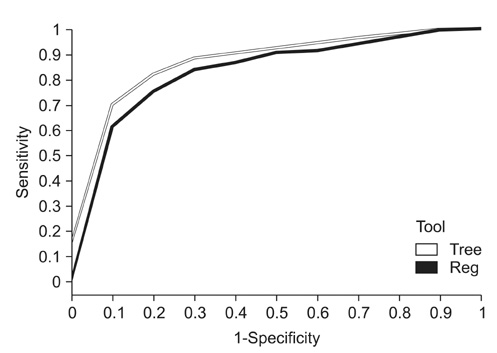Healthc Inform Res.
2011 Dec;17(4):253-259. 10.4258/hir.2011.17.4.253.
An Analysis of the Correlation between Alopecia and Chief Complaints
- Affiliations
-
- 1Seven Rhema Medical Science Research Institute, Seoul, Korea. ey7078@hanmail.net
- KMID: 2284552
- DOI: http://doi.org/10.4258/hir.2011.17.4.253
Abstract
OBJECTIVES
In this study, we measured the extent of ten levels of classified symptoms by 300 (male and female) patients visiting the hair loss clinics of "S" hospitals in Gangbuk and Gangnam between January 2009 and June 2011 by analyzing the patients' chief complaints.
METHODS
The method of measurement was based on a symptom questionnaire possessing 51 categories. Through the statistical analysis of data mining techniques, decision trees, and logistic regression, we derived a logistic regression model and decision tree model that improved both the response rate and significant hair loss-related characteristics of the questionnaire.
RESULTS
The results of this study indicate that dry hair, seborrheic scalps and skin, tobacco and/or coffee addiction, anxiety, nausea, indigestion, and facial flushing correlate to hair loss.
CONCLUSIONS
We anticipate that the subjective symptoms of hair loss can provide a foundation for preventing secondary diseases and provide clinical data information during the period of treatment. This can contribute to the improvement of patient satisfaction after customized treatment.
Keyword
MeSH Terms
Figure
Reference
-
1. Anderson I. Alopecia areata: a clinical study. Br Med J. 1950. 2:1250–1252.
Article2. Maffei C, Fossati A, Rinaldi F, Riva E. Personality disorders and psychopathologic symptoms in patients with androgenetic alopecia. Arch Dermatol. 1994. 130:868–872.
Article3. Fossati A, Rinaldi F, Maestroni L, Cappio F, Maffei C. Trichologic consultation and personality disorders. G Ital Dermatol Venereol. 1993. 128:101–108.4. Kantor J, Kessler LJ, Brooks DG, Cotsarelis G. Decreased serum ferritin is associated with alopecia in women. J Invest Dermatol. 2003. 121:985–988.
Article5. Hadshiew IM, Foitzik K, Arck PC, Paus R. Burden of hair loss: stress and the underestimated psychosocial impact of telogen effluvium and androgenetic alopecia. J Invest Dermatol. 2004. 123:455–457.
Article6. de Koning EB, Passchier J, Dekker FW. Psychological problems with hair loss in general practice and the treatment policies of general practitioners. Psychol Rep. 1990. 67(3 Pt 1):775–778.
Article7. Kim DH, Kim SN. The effect on hair loss for impression formation and interpersonal anxiety. Korean J Aesthet Cosmet Soc. 2010. 8:1–12.8. Schlenker BR, Leary MR. Social anxiety and self-presentation: a conceptualization and model. Psychol Bull. 1982. 92:641–669.9. Leary MR, Kowalsi RM, Campbell CD. Self-presentational concerns and social anxiety: the role of generalized impression expectancies. J Res Pers. 1988. 22:308–321.
Article10. Kim SJ, Kang SH, Kim WJ, Kim YM. The variation factors of severity: adjusted length of stay in CABG. J Korean Soc Quality Manage. 2011. 39:391–399.11. Yong WS, Park IS, Kang SH, Kim WJ, Kim KH, Kim KK, Park NY. Development of hypertension predictive model. J Korean Soc Health Educ Promot. 2006. 23:13–28.12. Park IS, Yong WS, Kim YM, Kang SH, Han JT. A development of a tailored follow up management model using the data mining technique on hypertension. Korean J Appl Stat. 2008. 21:649–657.
Article13. Luk JM, Lam BY, Lee NP, Ho DW, Sham PC, Chen L, Peng J, Leng X, Day PJ, Fan ST. Artificial neural networks and decision tree model analysis of liver cancer proteomes. Biochem Biophys Res Commun. 2007. 361:68–73.
Article14. Saritas I, Ozkan IA, Sert IU. Prognosis of prostate cancer by artificial neural networks. Expert Syst Appl. 2010. 37:6646–6650.
Article15. Sinclair R, Wewerinke M, Jolley D. Treatment of female pattern hair loss with oral antiandrogens. Br J Dermatol. 2005. 152:466–473.
Article16. Severi G, Sinclair R, Hopper JL, English DR, McCredie MR, Boyle P, Giles GG. Androgenetic alopecia in men aged 40-69 years: prevalence and risk factors. Br J Dermatol. 2003. 149:1207–1213.
Article17. Diaz-Atienza F, Gurpegui M. Environmental stress but not subjective distress in children or adolescents with alopecia areata. J Psychosom Res. 2011. 71:102–107.
Article18. Kim EK, Jeoung MY. A study on physical symptom of people who has alopecia using CMI method. J Korean Soc Cosmetol. 2009. 15:440–450.19. Lim HS, Lee CH, Ro BI. A clinical study of androgenetic alopecia (1994). Korean J Investig Dermatol. 1997. 4:27–34.20. Matzer F, Egger JW, Kopera D. Psychosocial stress and coping in alopecia areata: a questionnaire survey and qualitative study among 45 patients. Acta Derm Venereol. 2011. 91:318–327.
Article21. Fischer TW, Schmidt S, Strauss B, Elsner P. Hairdex: a tool for evaluation of disease-specific quality of life in patients with hair diseases. Hautarzt. 2001. 52:219–227.
- Full Text Links
- Actions
-
Cited
- CITED
-
- Close
- Share
- Similar articles
-
- A Case of Congenitally Developed Alopecia Areata
- Psychiatric Evaluations of Chronic Urticaria and Alopecia Areata by Cornell Medical Index
- Congenital Triangular Alopecia
- Proposal of Laboratory Test Panel Based on Patients' Chief Complaints in Emergency Department
- Efficacy of Oral Tofacitinib in Patients with Alopecia Areata: Tofacitinib Was Ineffective for Recalcitrant Alopecia Totalis of a Long Duration




